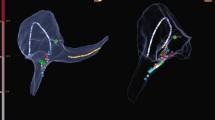Abstract
Background
A remote magnetic navigation system (MNS) has been developed for mapping and catheter ablation of cardiac arrhythmias. The present study evaluates the safety and feasibility of this system to perform radiofrequency (RF) ablation in patients with supraventricular tachycardias (SVT).
Methods
A total of 32 patients (22 female; mean age 44 ± 16 years) with documented SVT underwent mapping and ablation using Helios II (a 4-mm-tip magnetic catheter), under the guidance of the MNS (Niobe II, Stereotaxis, Inc.).
Results
Catheter ablation procedure with MNS was successful in 30/32 (94%) patients including all patients (27/27, 100%) with atrioventricular nodal reentrant tachycardia (AVNRT) and three of five patients (60%) with atrioventricular reentrant tachycardia (AVRT) without any complication. The procedural successful rate in patients with AVNRT was significantly higher than those in patients with AVRT (P < 0.001). Overall, the medium number of RF application using the MNS was 2 (mean 2.7 ± 1.6, range 1 to 7), and the medium numbers of RF for AVNRT and AVRT were 2 and 3, respectively. There was no significant difference in the mean procedural time between patients with AVNRT and AVRT (126.3 ± 38.6 vs. 138.0 ± 40.3 min, P = 0.54). However, the mean fluoroscopy time was significantly shorter in patients with AVNRT than those with AVRT (5.7 ± 3.0 vs. 16.5 ± 2.5 min, P < 0.001). Among those patients with AVNRT, the mean procedural time (139.3 ± 45.0 vs. 112.3 ± 24.9 min, P = 0.07) and fluoroscopic time (3.2 ± 1.0 vs. 8.0 ± 2.2 min, P < 0.001) were shorter for the later 13 patients than the first 14 patients, suggesting a learning curve in using the MNS for RF ablation.
Conclusions
The Niobe MNS is a new technique that can allow safe and effective remote-controlled navigation and minimize the need for fluoroscopic guidance for ablation catheter of AVNRT. However, further improvement is required to achieve a higher successful rate for treatment of AVRT.
Similar content being viewed by others
References
Nakagawa, H., & Jackman, W. M. (2007). Catheter ablation of paroxysmal supraventricular tachycardia. Circulation, 116, 2465–2478.
Efstathopoulos, E. P., Katritsis, D. G., Kottou, S., Kalivas, N., Tzanalaridou, E., Giazitzoglou, E., et al. (2006). Patient and staff radiation dosimetry during cardiac electrophysiology studies and catheter ablation procedures: A comprehensive analysis. Europace, 8, 443–448.
Faddis, M. N., Blume, W., Finney, J., Hall, A., Rauch, J., Sell, J., et al. (2002). Magnetically guided catheter for endocardial mapping and radiofrequency catheter ablation. Circulation, 106, 2980–2983.
Ernst, S., Ouyang, F., Linder, C., Hertting, K., Stahl, F., Chun, J., et al. (2004). Initial experience with remote catheter ablation using a novel magnetic navigation system: Magnetic remote catheter ablation. Circulation, 109, 1472–1475.
Faddis, M. N., Chen, J., Osborn, J., Talcott, M., Cain, M. E., & Lindsay, B. D. (2003). Magnetic guidance system for cardiac electrophysiology: A prospective trial of safety and efficacy in humans. Journal of the American College of Cardiology, 42, 1952–1958.
Kerzner, R., Sánchez, J. M., Osborn, J. L., Chen, J., Faddis, M. N., Gleva, M. J., et al. (2006). Radiofrequency ablation of atrioventricular nodal reentrant tachycardia using a novel magnetic guidance system compared to a conventional approach. Heart Rhythm, 3, 261–267.
Thornton, A. S., Rivero-Ayerza, M., Knops, P., & Jordaens, L. J. (2007). Magnetic navigation in left-sided AV reentrant tachycardias: Preliminary results of a retrograde approach. Journal of Cardiovascular Electrophysiology, 18, 467–472.
Chun, J. K., Ernst, S., Matthews, S., Schmidt, B., Bansch, D., Boczor, S., et al. (2007). Remote-controlled catheter ablation of accessory pathways: Results from the magnetic laboratory. European Heart Journal, 28, 190–195.
Lindsay, B. D. (2006). Perspectives on the development of a magnetic navigation system for remote control of electrophysiology catheters. Europace, 8, 231–232.
Pappone, C., Vicedomini, G., Manguso, F., Gugliotta, F., Mazzone, P., Gulletta, S., et al. (2006). Robotic magnetic navigation for atrial fibrillation ablation. Journal of the American College of Cardiology, 47, 1390–1400.
Author information
Authors and Affiliations
Corresponding authors
Additional information
Drs. Xu and Yang contributed equally to this work.
Rights and permissions
About this article
Cite this article
Xu, D., Yang, B., Shan, Q. et al. Initial clinical experience of remote magnetic navigation system for catheter mapping and ablation of supraventricular tachycardias. J Interv Card Electrophysiol 25, 171–174 (2009). https://doi.org/10.1007/s10840-008-9356-5
Received:
Accepted:
Published:
Issue Date:
DOI: https://doi.org/10.1007/s10840-008-9356-5




